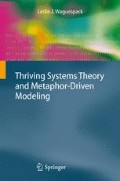Abstract
Christopher Alexander’s framework of living structure exploring the form and relationships of physical architecture explains the affinity that exists between the observer and the architecture. Alexander persuasively argues that the experience of life demonstrated in his image comparison experiments is conveyed through a lens sensitive to 15 discernible properties that evoke an observer’s sense of satisfaction in what they see. I believe that Alexander chose the term “life” without defining it to have each observer tap into their own visceral sense of satisfaction. Thus, Alexander’s framework bridges a distance in our understanding that separates what we think of as objective design quality and what observers experience as subjective design quality, what we call beauty.
Access this chapter
Tax calculation will be finalised at checkout
Purchases are for personal use only
Notes
- 1.
The observer’s mindset is illustrated as a collection of ideas (light bulbs).
- 2.
Expectations are illustrated as a plan or model of requisites that “define” what the observer is “looking for” or “expects” to observe.
- 3.
The threshold is illustrated as a keyboard or keystrokes as one might need to learn to exercise the communication between observer and system implementation.
- 4.
Nature versus nurture refers to the long standing debates concerning the degree to which life is shaped more or less predominantly by innate qualities (“nature”) versus experiences (“nurture”) in determining or causing individual differences in physical and behavioral traits.
- 5.
Hence, the reference to “imprecision” earlier to stakeholder intentions where the effort required to maintain a precise expression of the expectations is deemed too “expensive” and detail is reduced by some means.
- 6.
This is the basic tenet of marketing: “Create a need by posing an opportunity.”
- 7.
See Section 9.7.
References
McKean E (editor), The New Oxford American Dictionary, Second Edition, 2051 p, Oxford University Press, New York, May 2005.
Rowland D and Howe TN, Vitruvius. Ten Books on Architecture. Cambridge University Press, Cambridge, 1999.
Author information
Authors and Affiliations
Corresponding author
Rights and permissions
Copyright information
© 2010 Springer-Verlag London Limited
About this chapter
Cite this chapter
Waguespack, L.J. (2010). Thriving Systems and Beauty. In: Thriving Systems Theory and Metaphor-Driven Modeling. Springer, London. https://doi.org/10.1007/978-1-84996-302-2_11
Download citation
DOI: https://doi.org/10.1007/978-1-84996-302-2_11
Published:
Publisher Name: Springer, London
Print ISBN: 978-1-84996-301-5
Online ISBN: 978-1-84996-302-2
eBook Packages: Computer ScienceComputer Science (R0)

